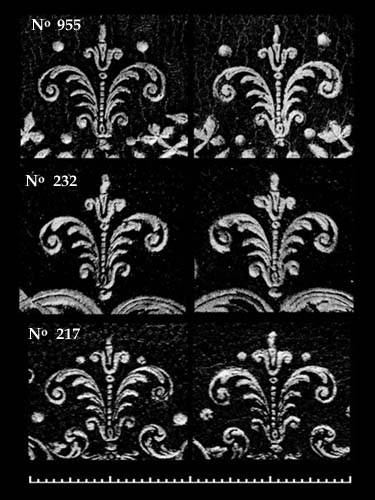

| I start this page with a comparative diagram showing examples of a fleuron which I have numbered as pd-1. This is really the first Dubuisson tool to catch my attention. I spotted it on his plaque binding reproduced in Rahir's 1936 catalogue as item 955. I have already detailed this on a previous page (see details). I then went on to find this same tool on Rahir 232 another plaque binding and then also on Rahir 217 which is not a plaque binding and here we find many important small tools. First however, you are going to ask, can we be sure this is the same tool, are the imprints the same? |
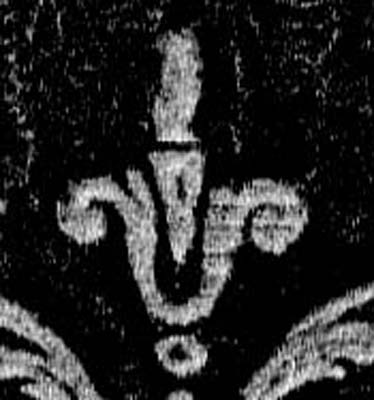
| In the much enlarged detail shown above, you will notice some rather vague parallel lines or transverse grooves. These I don't imagine to be deliberate, they do not fit in with the general stylistic pattern of the other tools. The reader will have to forgive the rather fuzzy image however without a high resolution digital scan we are lucky that we can perceive this detail at all. If you go back now and look at the 600dpi enlargement of all the samples above, you will see (only barely) that all these imprints reveal this same defect. These imprints then all derive from the same tool, and the bindings on which they are found, probably are all from the same workshop. |
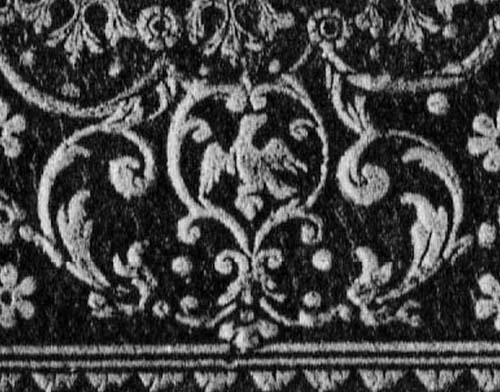
|
>Can we assume that the binding Rahir 217, was made and decorated by Dubuisson? We see within the tooled imprints several that have appeared on various other bindings that we know were produced by Dubuisson, as they are also decorated with his plaques. Further to this we know that another binding of this same publication carries Dubuisson's ticket as binder to the King (see the Librairie Clermont example). We also know that Dubuisson authored the book and that Rahir 217 appears to be a presentation binding that carries the arms of the King's wife MARIE LECZINSKA. I think, therefore, that it would be very likely that Dubuisson was the binder! In fact I think it very unlikely that he would have entrusted anyone else to the execution of such an important and prestigious item. In Comparative Diagram 2, I show an enlarged detail from Rahir 217. The enclosed figure of a bird is probably the most important imprint that we have yet discovered. |
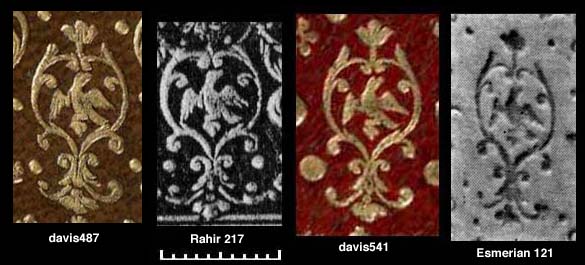
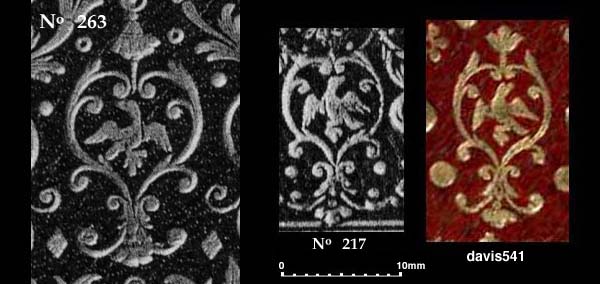
|
In comparative diagram 3, I have assembled a selection of imprints which I have called one o'clock birds, as a way of distinguishing them from the bird shown in Comparative Diagram 4, which appears to be looking the other way. My explanation is that the one o'clock birds appear to be looking in the direction of one o'clock, while the other is looking towards ten o'clock... this may seem ridiculously simplistic, but it is just a way of jolting the memory so it never forgets what we are looking at. Why is this so important? In the history of French Bookbinding there has never been a greater conundrum, indeed, it seems a sort of conspiracy. It would appear that at some dark, distant point in time, someone had the brain wave to associate these birds with the work of Derome le jeune, and this then, was passed down through history to become a sort of legend, but perhaps, not wholly correct. The ten o'clock bird shown above derives from Rahir 263 (which I shall reproduce at some later point) this binding is found on a 1772 publication of LE TEMPLE DE GNIDE. |
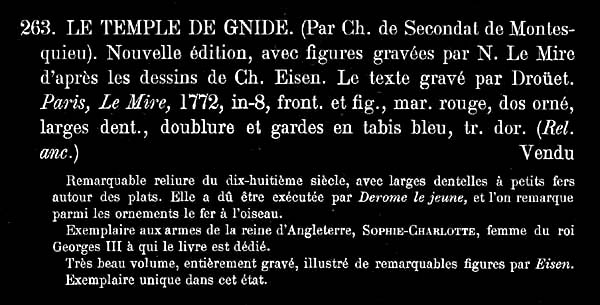
|
Rahir states in his description of the binding, that this ought be the work of Derome le jeune, and we can see within the ornamentation "le fer à l'oiseau" (the iron of a bird). The ten o'clock bird then is quite likely to be the one associated with Derome, you can see that it is a bit larger, but very, very similar, in fact it is a reverse copy of Dubuisson's bird. Now here is the catch, it appears that no one has associated these birds with Dubuisson. all birds have been assigned to Derome! Let us look at a few big mistakes that have been made by the experts in this issue. First, I present in Comparative Diagram 5, another detail from the Rahir 217 binding of Dubuisson's 1757 Armorial. |
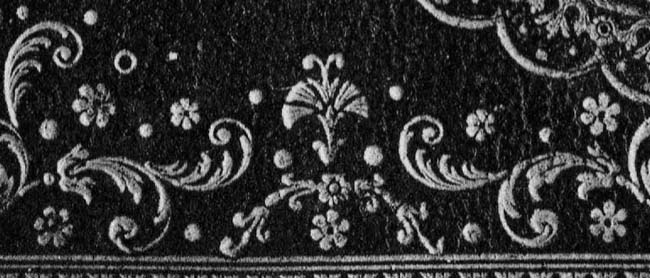
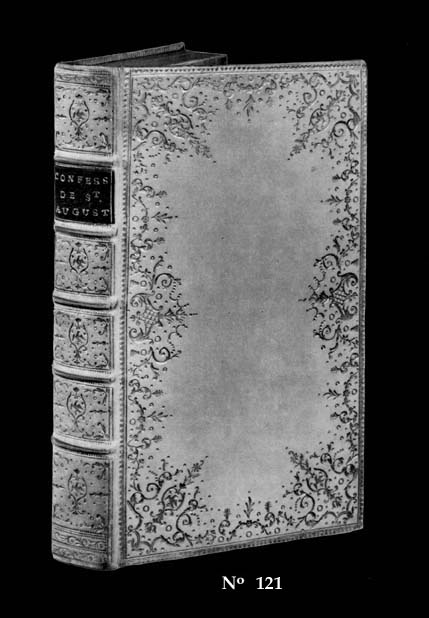
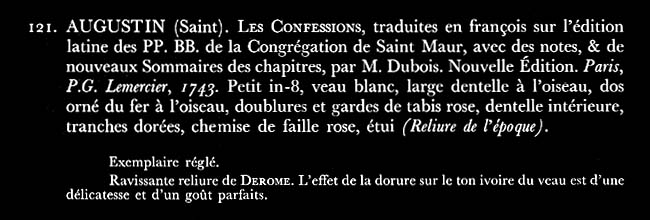
| Above is item No. 121 from Esmerian's 1972 catalogue, in his description of this binding, he mentions the dentelle à l'oiseau and attributes the binding to Derome. Please see, in Comparative Diagram 3, the extracted one o'clock bird imprint from this binding, as well as the enlarged corned detail below, this is Dubuisson's one o'clock bird! |
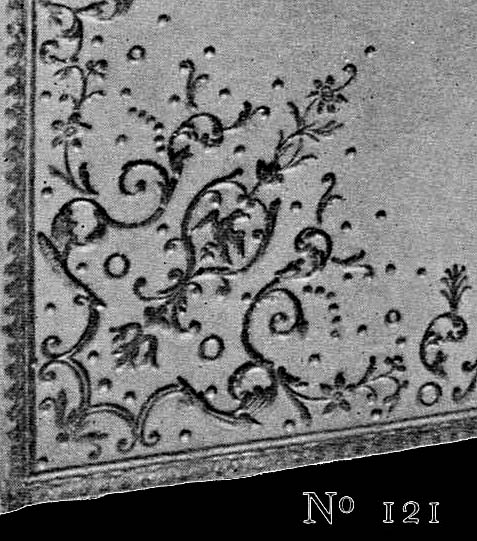
| Should we have any further doubts, Comparative Diagram 6 reveals another important Dubuisson tool imprint (pd-5). |
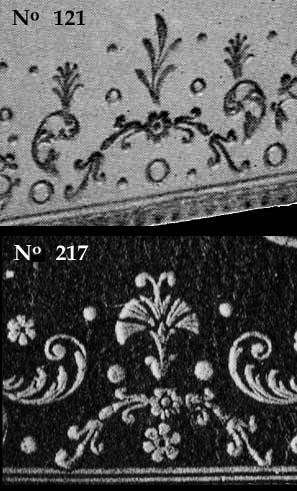
| On the next page we will examine some important examples from British Library Database of Bookbindings. |
|
click on this link to go to the next page: Dubuisson - Imprint Catalogue
click on this link to return to: The Dubuisson Plaque Inventory |
| Go to Digital Alchemy | return to the home page of cyclopaedia.org |